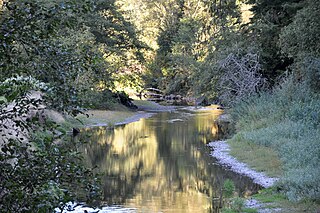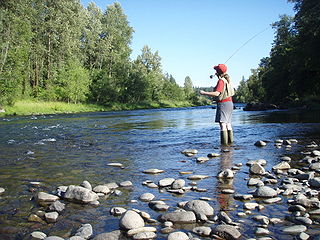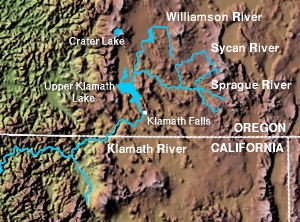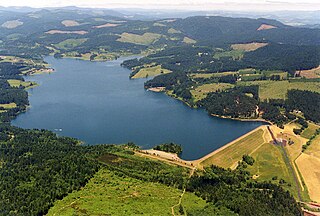| Skipanon River | |
|---|---|
| Etymology | A Clatsop Indian word, Skippernawin referred to a point at the mouth of the stream [1] |
| Location | |
| Country | United States |
| State | Oregon |
| County | Clatsop County |
| Physical characteristics | |
| Source | N. Oregon coastal foothills & Cullaby Lake |
| - location | Clatsop County, Oregon |
| - coordinates | 46°05′39″N123°54′32″W / 46.09417°N 123.90889°W [2] |
| - elevation | 50 ft (15 m) [3] |
| Mouth | Columbia River |
| - location | Warrenton, Clatsop County, Oregon |
| - coordinates | 46°10′9″N123°55′37″W / 46.16917°N 123.92694°W Coordinates: 46°10′9″N123°55′37″W / 46.16917°N 123.92694°W [2] |
| - elevation | .5 ft (0.15 m) [2] |
| Length | 7 mi (11 km) |
The Skipanon River is a tributary of the Columbia River, approximately 7 miles (11 km) long, on the Pacific coast of northwest Oregon in the United States. It is the last tributary of the Columbia on the Oregon side, draining an area of coastal bottom land bordered by sand dunes and entering the river from the south at its mouth west of Astoria.

The Columbia River is the largest river in the Pacific Northwest region of North America. The river rises in the Rocky Mountains of British Columbia, Canada. It flows northwest and then south into the US state of Washington, then turns west to form most of the border between Washington and the state of Oregon before emptying into the Pacific Ocean. The river is 1,243 miles (2,000 km) long, and its largest tributary is the Snake River. Its drainage basin is roughly the size of France and extends into seven US states and a Canadian province. The fourth-largest river in the United States by volume, the Columbia has the greatest flow of any North American river entering the Pacific.

The Pacific Ocean is the largest and deepest of Earth's oceanic divisions. It extends from the Arctic Ocean in the north to the Southern Ocean in the south and is bounded by Asia and Australia in the west and the Americas in the east.

Oregon is a state in the Pacific Northwest region on the West Coast of the United States. The Columbia River delineates much of Oregon's northern boundary with Washington, while the Snake River delineates much of its eastern boundary with Idaho. The parallel 42° north delineates the southern boundary with California and Nevada. Oregon is one of only three states of the contiguous United States to have a coastline on the Pacific Ocean.
Contents
The Skipanon River issues from Cullaby Lake in western Clatsop County, northeast of Seaside and less than 3 miles (4.8 km) from the ocean. It flows north parallel to the coast and east of U.S. Route 101. It enters the northwest end of Youngs Bay at the mouth of the Columbia approximately 1 mile (1.6 km) northeast of Warrenton. The mouth of the river is at river mile 10.7 miles (17.2 km) of the Columbia upstream from its mouth.
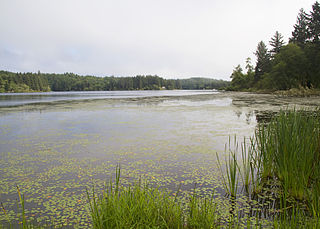
Cullaby Lake is a lake near Warrenton, Oregon, United States. It is the central feature of Cullaby Lake County Park, and one of the major lakes of Clatsop Plains.

Clatsop County is a county in the U.S. state of Oregon. As of the 2010 census, the population was 37,039. The county seat is Astoria. The county is named for the Clatsop tribe of Native Americans, who lived along the coast of the Pacific Ocean prior to European settlement.

Seaside is a city in Clatsop County, Oregon, United States. The name Seaside is derived from Seaside House, a historic summer resort built in the 1870s by railroad magnate Ben Holladay. The city's population was 6,457 at the 2010 census.
The river's name comes from the Clatsop language, originally referring to a point at the river's mouth rather than the river itself. The charts of the Lewis and Clark Expedition show the stream as Skipanarwin Creek. Another variant spelling, Skeppernawin, was common on maps into the 20th century. [1]

The Lewis and Clark Expedition from May 1804 to September 1806, also known as the Corps of Discovery Expedition, was the first American expedition to cross the western portion of the United States. It began near St. Louis, made its way westward, and passed through the Continental Divide of the Americas to reach the Pacific coast. The Corps of Discovery was a selected group of US Army volunteers under the command of Captain Meriwether Lewis and his close friend Second Lieutenant William Clark.





